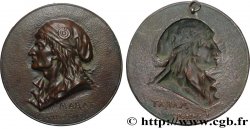E-auction 644-652989 - fme_1051993 - THE CONVENTION Médaille, Marat
You must signin and be an approved bidder to bid, LOGIN TO BID. Accounts are subject to approval and the approval process takes place within 48 hours. Do not wait until the day a sale closes to register. Clicking on « bid » constitutes acceptance of the terms of use of cgb.fr private e-auctions.
Bids must be placed in whole Euro amounts only. The sale will start closing at the time stated on the item description; any bids received at the site after the closing time will not be executed. Transmission times may vary and bids could be rejected if you wait until the last second. For further information ckeck the E-auctions F.A.Q.
NO BUYER'S FEE.
NO BUYER'S FEE.
| Estimate : | 10 € |
| Price : | 1 € |
| Maximum bid : | 2 € |
| End of the sale : | 18 August 2025 20:50:40 |
| bidders : | 1 bidder |
Type : Médaille, Marat
Date: n.d.
Metal : copper
Diameter : 27 mm
Orientation dies : 12 h.
Weight : 8,70 g.
Edge : lisse
Puncheon : sans poinçon
Coments on the condition:
Jolie patine marron hétérogène. Présence de traces d’oxydation, de rayures, de taches noires, d’usure sur les reliefs et de marques de manipulation notamment sur l’avers. De légers coups sont présents sur la tranche. Le revers présente des concrétions vertes et un ajout de matière (reste d’attache de bouton probablement)
Obverse
Obverse legend : MARAT - 1746--1793.
Obverse description : Buste de profil à gauche .
Reverse
Reverse legend : LISSE.
Commentary
Jean-Paul Marat, né le 24 mai 1743 à Boudry (Principauté de Neuchâtel) et mort le 13 juillet 1793 à Paris, est un médecin, physicien, journaliste et homme politique français d’origine prussienne. Usurpateur de noblesse avant la chute du régime monarchique, il devient député montagnard à la Convention à l’époque de la Révolution. Il joue un rôle de premier plan dans les premières années de la Révolution, grâce à son journal, L'Ami du peuple. Fréquemment accusé d'inciter à la violence, il est l'un des principaux instigateurs des Massacres de Septembre.
Son assassinat par Charlotte Corday permet aux hébertistes et aux robespierristes de faire de lui un martyr de la Révolution, d'installer pendant quelques mois ses restes au Panthéon et de justifier la Terreur.(c.f.Wikipédia).
Jean-Paul Marat, born May 24, 1743 in Boudry (Principality of Neuchâtel) and died July 13, 1793 in Paris, was a French doctor, physicist, journalist, and politician of Prussian origin. A nobility usurper before the fall of the monarchical regime, he became a Montagnard deputy to the Convention at the time of the Revolution. He played a leading role in the early years of the Revolution, thanks to his newspaper, L'Ami du peuple. Frequently accused of inciting violence, he was one of the main instigators of the September Massacres. His assassination by Charlotte Corday allowed the Hébertists and Robespierrists to make him a martyr of the Revolution, to install his remains in the Panthéon for a few months, and to justify the Terror. (cf. Wikipedia)
Son assassinat par Charlotte Corday permet aux hébertistes et aux robespierristes de faire de lui un martyr de la Révolution, d'installer pendant quelques mois ses restes au Panthéon et de justifier la Terreur.(c.f.Wikipédia).
Jean-Paul Marat, born May 24, 1743 in Boudry (Principality of Neuchâtel) and died July 13, 1793 in Paris, was a French doctor, physicist, journalist, and politician of Prussian origin. A nobility usurper before the fall of the monarchical regime, he became a Montagnard deputy to the Convention at the time of the Revolution. He played a leading role in the early years of the Revolution, thanks to his newspaper, L'Ami du peuple. Frequently accused of inciting violence, he was one of the main instigators of the September Massacres. His assassination by Charlotte Corday allowed the Hébertists and Robespierrists to make him a martyr of the Revolution, to install his remains in the Panthéon for a few months, and to justify the Terror. (cf. Wikipedia)








 Report a mistake
Report a mistake Print the page
Print the page Share my selection
Share my selection Ask a question
Ask a question Consign / sell
Consign / sell
 Full data
Full data









